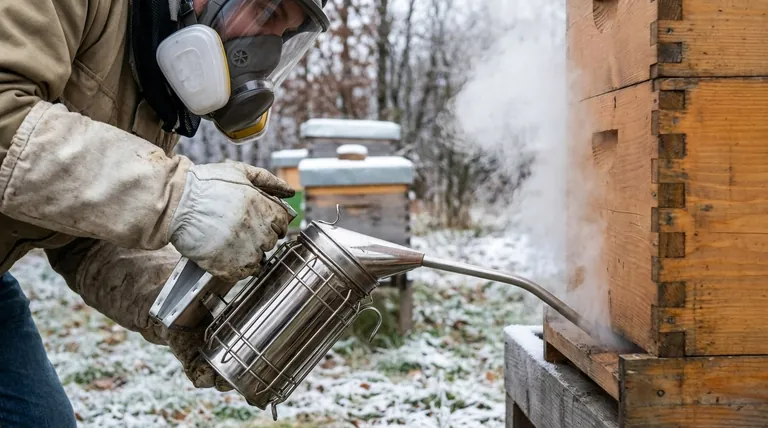When used correctly, oxalic acid is a highly effective treatment against Varroa mites, capable of achieving a success rate of 90% or higher. Its efficacy is maximized when applied to a colony with little or no capped brood, as it targets mites on adult bees.
The core principle to understand is that oxalic acid's effectiveness is not about the chemical itself, but about the timing of its application. It is exceptionally potent against mites on adult bees (phoretic mites) but completely ineffective against mites reproducing under the protection of capped brood.

How Oxalic Acid Achieves High Efficacy
Oxalic acid is a powerful tool in an integrated pest management plan, but its success hinges on understanding its specific mode of action and its limitations.
The Mechanism of Action
The leading theory is that oxalic acid is absorbed through the soft pads on the Varroa mite's feet. From there, it enters the mite's bloodstream, leading to its death. Adult honey bees, when exposed to proper dosages, do not suffer the same adverse effects.
Why Brood Status is the Critical Factor
The single most important factor determining the success of an oxalic acid treatment is the amount of capped brood in the hive. Mites reproduce under these cappings, where they are shielded from the acid.
Therefore, a single treatment during a period of heavy brooding will only kill the mites currently on adult bees, leaving the vast majority of the mite population unharmed and ready to emerge.
Measuring Success: The Numbers
When applied during a broodless period, the efficacy rates are consistently high. Studies and beekeeper reports show mite mortality rates between 90% and 95%. Some application methods, like sublimation, can achieve success rates as high as 97.6%.
Common Application Methods
There are two primary methods for applying oxalic acid, each with its own procedure and considerations.
The Drip Method
This method involves mixing oxalic acid dihydrate with a sugar syrup solution. The beekeeper then opens the hive and trickles, or "drips," a measured amount of the solution directly onto the bees between the frames.
The Sublimation (Vaporization) Method
In this method, oxalic acid crystals are heated in a specialized device called a vaporizer. The heat turns the solid crystals directly into a gas (sublimation), which fills the hive and coats the bees and surfaces. This is often preferred as it can be done without fully opening the hive.
Understanding the Key Limitation
To use oxalic acid responsibly and effectively, you must understand its primary constraint.
The "No Brood" Rule
As stated, oxalic acid does not penetrate the wax cappings of brood cells. This is not a partial limitation; it is an absolute one. Any mites inside those cells are completely safe from the treatment.
Timing is Everything
This limitation is why oxalic acid is most often used in late fall or winter when the queen has naturally stopped laying. It is also effective during an artificial "brood break," such as after hiving a new swarm or package that has not yet produced capped brood.
The Ineffectiveness of Single Treatments During Brood Rearing
Applying a single dose of oxalic acid to a colony with a large, active brood nest will yield poor results. While it will kill some mites, it will not significantly impact the overall mite population, giving the beekeeper a false sense of security. If brood is present, a multi-stage application plan would be necessary to catch mites as they emerge.
Making the Right Choice for Your Goal
To integrate oxalic acid into your Varroa management strategy, align the treatment with your specific goal and hive condition.
- If your primary focus is a rapid mite reduction in a broodless colony: Oxalic acid is one of the most effective and efficient treatments available, especially during the late fall or winter.
- If your primary focus is treating a hive with a large amount of capped brood: A single oxalic acid treatment will be ineffective and a different management strategy is required.
Ultimately, using oxalic acid effectively means understanding its power against phoretic mites and its powerlessness against those hidden in the brood.
Summary Table:
| Factor | Impact on Efficacy | Key Takeaway |
|---|---|---|
| Brood Status | Critical | Maximum efficacy (90%+) when applied to a broodless colony. |
| Application Method | Significant | Drip and sublimation methods can achieve 97%+ success rates. |
| Timing of Application | Essential | Late fall/winter or during an artificial brood break is ideal. |
Optimize your Varroa mite control with the right equipment.
Oxalic acid treatment is a cornerstone of effective Integrated Pest Management (IPM), but its success depends on precise application. HONESTBEE supplies commercial apiaries and distributors with the high-quality, reliable beekeeping supplies needed for successful treatments, including oxalic acid vaporizers and safety gear.
Let us help you protect your investment and ensure hive health.
Contact HONESTBEE today to discuss your wholesale needs and build a more resilient, productive operation.
Visual Guide

Related Products
- Professional Bamboo Queen Isolation Cage
- Professional Plastic Queen Excluder for Modern Beekeeping
- Langstroth Screen Bottom Board for Beekeeping Wholesale
- Metal Queen Bee Excluder for Beekeeping
- Professional Drop-Style Hive Handles for Beekeeping
People Also Ask
- Where should the queen bee's cage be placed in the hive? Maximize Acceptance in the Brood Nest
- What is sequestration, and how does it help bees reorient? A Safer Guide to Hive Relocation
- Why is the candy in shipping cages important? Ensure Your Queen Bee is Accepted by the Hive
- How should a queen cage be maintained over time? Ensure Queen Introduction Success
- What are the components of a standard queen cage? A Guide to Safe Queen Introduction



















